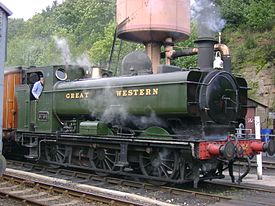GWR Pannier 5764
| GWR Pannier 5764 | |
|---|---|
 5764 at Bewdley | |
| Built By | GWR Swindon Works |
| Configuration | 0-6-0PT |
| Power class | 4F |
| Status | Out of service |
| Loco Number | 5764 |
| History | |
| Built | 1929 |
| Designed By | Charles Collett |
| Type | GWR 5700 |
| 1971 | Purchased from London Transport |
| 2011 | Withdrawn for overhaul |
| Technical | |
| Length | 31ft 2" |
| Weight | 47t 10cwt |
5764 is a GWR Collett 5700 class 0-6-0PT ‘pannier tank’, one of two examples on the SVR (the other being 7714).
Contents
5764 in service
The GWR 5700 class 0-6-0PT ‘pannier tank’ was the largest class of engine designed and built by the Great Western Railway; more than 860 were built between 1929 and 1950. Pannier tanks could be found at work all over the former GWR system and although designed primarily for shunting duties, they were regularly used on local freight and passenger workings. The class was rated 4F by British Railways.
5764 was built at Swindon and entered service in 1929 at London’s Old Oak Common depot. It remained at that depot post-War, serving the GWR and BR for more than thirty years before being withdrawn by BR in May 1960 having run an estimated 520,259 miles in service.
BR sold a number of pannier tanks, including 5764, to London Transport who used them mainly to run engineering trains on their Metropolitan Lines, operating from their Neasden Depot. While there, 5764 was allocated the number L95.
5764 in preservation
5764 was acquired direct from London Transport, arriving in LT livery on 19 June 1971 and entering service the same year. An indication of how quickly it entered service may be judged by the lighting of a fire in the engine whilst it was being unloaded from the low-loader.
In November 1973, 5764 was used in the filming of the BBC children's television series Carrie's War. In 1976, 5764 was used in filming of the BBC's The Signalman.
5764 last saw service in January 2011. The locomotive is currently stored at Kidderminster Carriage Shed, a facility not normally accessible to the general public.
The locomotive is owned by the SVR Pannier Tank Fund who also own GWR Pannier 7714.
See also
References